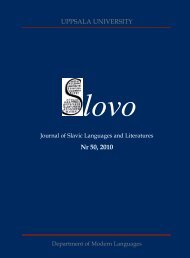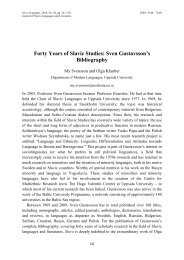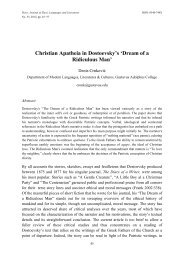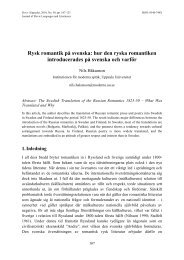UPPSALA UNIVERSITY - Index of - Uppsala universitet
UPPSALA UNIVERSITY - Index of - Uppsala universitet
UPPSALA UNIVERSITY - Index of - Uppsala universitet
- No tags were found...
Create successful ePaper yourself
Turn your PDF publications into a flip-book with our unique Google optimized e-Paper software.
Slovo (<strong>Uppsala</strong>), 2010, No. 51, pp. 115–127 ISSN: 0348-744XJournal <strong>of</strong> Slavic Languages and LiteraturesSpoken vs. Written or Dialogue vs. Non-Dialogue?Frequency Analysis <strong>of</strong> Verbs, Nouns and PrepositionalPhrases in Bulgarian Daniela AssenovaDepartment <strong>of</strong> Modern Languages, <strong>Uppsala</strong> UniversityDaniela.Assenova@moderna.uu.seAbstractIn linguistics, the difference between spoken and written language is <strong>of</strong>ten interpreted in terms <strong>of</strong>frequency, meaning the extent <strong>of</strong> the likelihood that some constructions will occur in written texts,rather than in the spoken form <strong>of</strong> a language, or vice versa. For Bulgarian, frequency analyses forparticular constructions are still rare and the term “frequency” generally remains implicit to the writtenor the spoken form <strong>of</strong> the language. In this paper it is argued that the term “frequency” can bemeaningful only if it is grounded in an analysis <strong>of</strong> both written and spoken texts. The primary focus <strong>of</strong>the study is the frequency <strong>of</strong> verbs, nouns and prepositional phrases in different types <strong>of</strong> spoken andwritten samples. Since neither the written nor the spoken form <strong>of</strong> Bulgarian, or, indeed, <strong>of</strong> anylanguage, can be considered homogeneous, it is argued that the differences between spoken andwritten language can be viewed as differences between dialogue and non-dialogue: i.e., that it is notthe mode itself, but rather the structuring <strong>of</strong> information and its density, which constitutes thedifference between the spoken and written modes.1. IntroductionMost people would agree intuitively that there is a significant difference betweenspoken and written language. For native speakers, however, the switch betweenspeaking and writing happens automatically, in a given situation, in accordance withthe purpose <strong>of</strong> their communication and social conventions. For example, if twostudents are communicating with each other during an ongoing class, the final productmay result in a written text, in order not to disturb the lecture, but in the structuring <strong>of</strong>the information in question/answer sequences, their written text would be more similarto an oral conversation, in the sense that the information is structured ad hoc, with no This paper presents preliminary results <strong>of</strong> work in progress.115












